
The American Game is an American breed of game fowl, chickens bred specifically for cockfighting. It has many color varieties, and may also be kept for ornament.
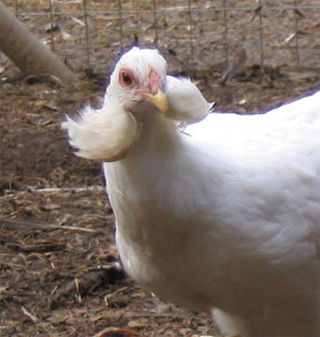
The Araucana is a breed of domestic chicken from Chile. Its name derives from the Araucanía region of Chile where it is believed to have originated. It lays blue-shelled eggs, one of very few breeds that do so.

The Orpington is a British breed of chicken. It was bred in the late nineteenth century by William Cook of Orpington, at that time in Kent in south-east England. It was intended to be a dual-purpose breed, to be reared both for eggs and for meat, but soon became exclusively a show bird.

The Cochin is a breed of large domestic chicken. It derives from large feather-legged chickens brought from China to Europe and North America in the 1840s and 1850s. It is reared principally for exhibition. It was formerly known as Cochin-China.

The Indian Game is a British breed of game chicken, now reared either for meat or show. It originated in the early nineteenth century in the counties of Cornwall and Devon in south-west England. It is a heavy, muscular bird with an unusually broad breast; the eggs are brown.

The Pekin Bantam is a British breed of bantam chicken. It derives from birds brought to Europe from China in the nineteenth century, and is named for the city of Peking where it was believed to have originated. It is a true bantam, with no corresponding large fowl. It is recognised only in the United Kingdom, where the Cochin has no recognised bantam version; like the Cochin, it has heavy feathering to the legs and feet. The Entente Européenne treats the Pekin Bantam as equivalent to the bantam Cochin.
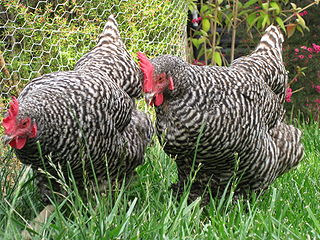
The Plymouth Rock is an American breed of domestic chicken. It was first seen in Massachusetts in the nineteenth century and for much of the early twentieth century was the most widely kept chicken breed in the United States. It is a dual-purpose bird, raised both for its meat and for its brown eggs. It is resistant to cold, easy to manage, and a good sitter.

The Japanese Bantam or Chabo is a Japanese breed of ornamental chicken. It is a true bantam breed, meaning that it has no large fowl counterpart. It characterised by very short legs and a large upright tail that reaches much higher than the head of the bird.
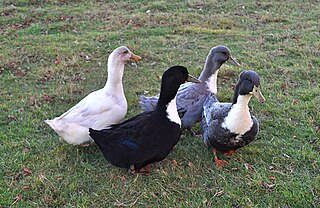
The Swedish Blue or Blue Swedish is a Swedish breed of domestic duck. It originated in the former dominion of Swedish Pomerania – now in north-west Poland and north-east Germany – and is documented there from 1835. It is closely similar to the Pomeranian Duck from the same general area, differing mainly in its white primary feathers.
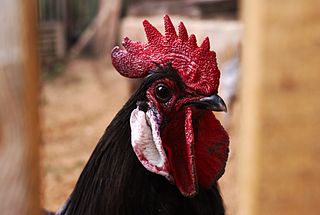
The Blue Andalusian, Spanish: Andaluza Azul, is a breed of domestic chicken indigenous to the autonomous community of Andalusia in south-west Spain. It is distributed through much of the countryside of Córdoba and Seville, and is concentrated particularly in the area of Utrera, which is considered the heartland of the breed. In 2009 the population was estimated at 10000 birds.

The New Hampshire Red or New Hampshire is an American breed of chicken. It was developed in the early twentieth century in the state of New Hampshire by selective breeding of Rhode Island Red stock; no other breed was involved. It is fast-growing, early-maturing, quick-feathering, and yields a meaty carcass. Mature birds are a light or medium red in color; they may fade in sunlight.
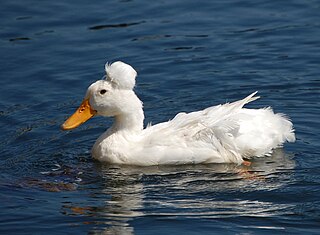
The Crested is a breed of domestic duck. It was probably brought to Europe from the East Indies by Dutch ships. It has its appearance because it is heterozygous for a genetic mutation causing a deformity of the skull.

The Magpie is a British breed of domestic duck. It has distinctive black and white markings reminiscent of the European magpie, and is a good layer of large eggs.

The Ameraucana is an American breed of domestic chicken. It was developed in the United States in the 1970s, and derives from Araucana chickens brought from Chile. It was bred to retain the blue-egg gene but eliminate the lethal alleles of the parent breed. There are both standard-sized and bantam versions.

The Sebright is a British breed of bantam chicken. It is a true bantam – a miniature bird with no corresponding large version – and is one of the oldest recorded British bantam breeds. It is named after Sir John Saunders Sebright, who created it as an ornamental breed by selective breeding in the early nineteenth century.

The Naked Neck is a breed of chicken that is naturally devoid of feathers on its neck and vent. The breed is also called the Transylvanian Naked Neck, as well as the Turken. The name "Turken" arose from the mistaken idea that the bird was a hybrid of a chicken and the domestic turkey. Naked Necks are fairly common in Europe today, but are rare in North America and very common in South America. The trait for a naked neck is a dominant one controlled by one gene and is fairly easy to introduce into other breeds, however these are hybrids rather than true Naked Necks, which is a breed recognized by the American Poultry Association since 1965, it was introduced in Britain in the 1920s. There are other breeds of naked necked chicken, such as the French naked neck, which is often confused with the Transylvanian, and the naked necked gamefowl.

The Modern Game is a British breed of ornamental chicken which originated in England between 1850 and 1900. It was bred from gamecock stock, but solely as an exhibition bird.

The Silver Appleyard is a British breed of domestic duck. It was bred in the first half of the twentieth century by Reginald Appleyard, with the aim of creating a dual-purpose breed that would provide both a good quantity of meat and plenty of eggs.

The Onagadori is a historic Japanese breed of chicken, characterised by an exceptionally long tail. It was bred in the seventeenth century in Kōchi Prefecture, on Shikoku island in southern Japan, and was designated a Japanese National Natural Treasure in 1952. It is one of the ancestors of the German Phoenix breed.

The Niederrheiner is a German breed of chicken. It is named for the Niederrhein or Lower Rhine region where it originated in the early twentieth century, and derives principally from the Dutch North Holland Blue meat chicken. It was recognized in Germany in 1943. In the twenty-first century it is an endangered breed.






















